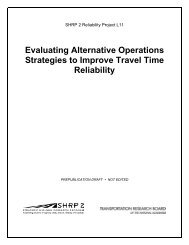Land Use and Traffic Congestion - SSTI
Land Use and Traffic Congestion - SSTI
Land Use and Traffic Congestion - SSTI
Create successful ePaper yourself
Turn your PDF publications into a flip-book with our unique Google optimized e-Paper software.
EXECUTIVESUMMARY<br />
The purpose of this project was to analyze <strong>and</strong> interpret the relationship between higherdensity<br />
development <strong>and</strong> traffic congestion. Governments have expressed increased<br />
interest in the possible benefits of compact, mixed l<strong>and</strong> use—referred to in many circles<br />
as smart growth—to reduce auto dependency <strong>and</strong> use. If true, this finding could be of<br />
significance in planning solutions to a host of transportation system investment,<br />
performance, <strong>and</strong> impact issues.<br />
Before considering any type of formal policy position in relation to l<strong>and</strong> use, the Arizona<br />
Department of Transportation (ADOT) is exp<strong>and</strong>ing its underst<strong>and</strong>ing of the relationships<br />
between l<strong>and</strong> use development patterns <strong>and</strong> transportation. Among ADOT’s key<br />
questions are:<br />
Does higher-density development reduce auto use, to what extent, <strong>and</strong> in response<br />
to what factors?<br />
Does higher-density development also generate higher levels of traffic congestion<br />
simply due to the higher concentration of activity?<br />
Do Arizonans know about smart growth, <strong>and</strong> what are their perceptions of its<br />
impacts <strong>and</strong> desirability?<br />
The research study that is summarized in this report was commissioned to address these<br />
specific issues. It involved a national-scale review of research <strong>and</strong> evidence on<br />
transportation <strong>and</strong> l<strong>and</strong> use relationships; detailed local analysis of these relationships<br />
using data from metropolitan Phoenix; <strong>and</strong> a survey of officials in Arizona’s metropolitan<br />
areas about their perceptions of l<strong>and</strong> use/transportation, how higher-density development<br />
is viewed, <strong>and</strong> whether there would be receptiveness for compact, mixed-use approaches<br />
regionally <strong>and</strong> in their own area.<br />
The findings of this study confirm the benefits of better l<strong>and</strong> use. In its assessment of a<br />
prodigious volume of research on this topic, the project’s literature review was able to<br />
highlight the following findings:<br />
Density <strong>and</strong> Vehicle Miles Traveled Using residential density as a primary<br />
indicator of concentrated l<strong>and</strong> use, a variety of studies have shown that<br />
households in higher-density (i.e., more urban) settings tend to own fewer<br />
vehicles, drive less, walk <strong>and</strong> take transit more often, <strong>and</strong> generate one-half to<br />
one-third of the daily vehicle miles traveled (VMT) of their suburban<br />
counterparts.<br />
Beyond Density: Research has found that the effects of l<strong>and</strong> use on travel<br />
behavior are rooted in factors beyond simple density. Also important are related<br />
factors such as mix of uses, auto- vs. pedestrian-oriented design, <strong>and</strong> regional<br />
accessibility enhanced by multiple travel choices (especially transit). These<br />
characteristics of density, diversity, design, <strong>and</strong> destinations are commonly<br />
referred to as the 4Ds.<br />
Travel Purpose: Work travel, which is associated with peak period congestion,<br />
generally garners most of the attention in transportation planning <strong>and</strong> policy<br />
deliberations. Indeed, where compact l<strong>and</strong> use is focused around high-quality<br />
1<br />
141 of 226















